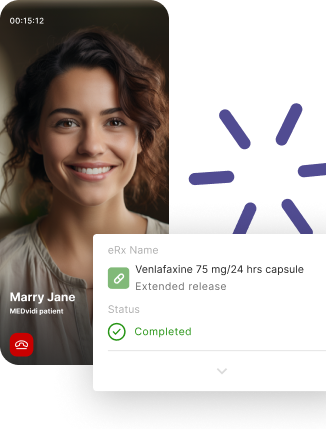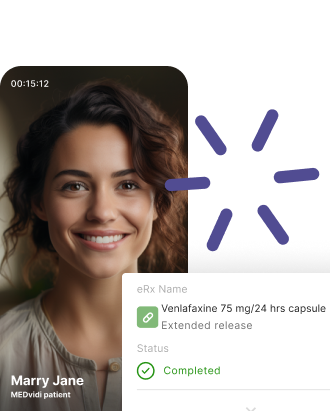Highlights
- Adderall is a stimulant medication that is used in the treatment of ADHD and narcolepsy.
- How long Adderall’s effects last varies based on its formulation and dosage. The extended-release version lasts longer than the immediate-release.
- Metabolism, hydration level, diet, age, and health status can influence how long Adderall remains in your system.
- Drug tests may detect Adderall and return as a false positive for specific drugs, making it important to consider its use when undergoing drug tests for school or a job.
Adderall is a stimulant medication used primarily in the treatment of attention deficit hyperactivity disorder (ADHD). In addition to knowing how it increases attention, it’s also important to know why it comes with a risk of addiction and how long Adderall takes to leave your system. This can influence your treatment plan and the duration of side effects.
See a healthcare provider online


Adderall Overview
Adderall is often used to treat attention deficit hyperactivity disorder (ADHD) and narcolepsy. Its active ingredients amphetamine and dextroamphetamine stimulate the nervous system and influence specific brain chemicals, which improves attention and impulse control.
It is
How Long Does Adderall Stay in Your System?
The answer depends on many chemical and physiological factors, but the most important one is the medication’s formulation. Adderall is available in two forms:
- Adderall IR (immediate-release) typically lasts for 4-6 hours
- Adderall XR (extended-release) lasts up to 8 to 12 hours
These durations influence how often the medication is taken and are why following your doctor’s prescription instructions is crucial to avoid or limit negative effects.
In addition to the formulation, the Adderall dose prescribed can influence whether its effects fall at the upper or lower part of the range—the higher the dose, the longer its effects may last. This is because the average half-life of Adderall is approximately 10 hours, which means during this period, its amount in the system gets halved. So, a higher prescribed dose means your body will need more time to eliminate the medication step by step.
How Long Does Adderall Last in Different Systems?
Adderall, as an oral medication, is absorbed through the gastrointestinal tract, broken down (metabolized) by the liver, and then excreted through urine. With all these areas that Adderall hits, each has varying amounts of time that they hold onto Adderall—some may be rid of it sooner than others.
For example, Adderall in your blood can be detected using a blood test up to 46 hours after the last dose. Blood tests are also the first detectors of Adderall when you first start taking it.
Adderall levels in urine can be detected for 72 to 96 hours after its last use. Furthermore, since the medication is excreted through urine, urine tests often show a higher concentration of Adderall than you would see from other tests.
Your saliva can be one of the areas that Adderall fades from the quickest, with saliva tests able to detect Adderall 20 to 50 hours after use.
At the opposite end of the spectrum, Adderall can even be detectable in your hair, although it’s not a common testing method. However, your hair can hold onto traces of Adderall for 3 months after you stop taking it.
Based on these different tests, it may take 20 to 96 hours after your last dose for Adderall to get out of your system, with the duration varying based on the system being tested.
Factors Influencing How Long Adderall Remains in Your System
Everyone’s body is different, which is why the duration that Adderall remains in the system can vary by person. Below are some of the key factors to consider.
Metabolism
One of the greatest influences for how long Adderall works has to do with how it is metabolized. Adderall is orally ingested and metabolized by your liver, yet everyone’s metabolism is not the same. Just like how your walking speed can be influenced by the length of your legs and your energy levels, the speed at which you metabolize medicine can vary compared to others.
As expected, the slower the metabolism, the longer Adderall remains in your system. Some factors that can affect your metabolism include:
- Gender
- Activity level
- Age
- Presence of liver problems

Dosage
The higher the dosage noted in your Adderall prescription, the more medicine you intake and the longer it takes to remove it all. Additionally, while the formulation (i.e., immediate-release or extended-release) affects how long Adderall takes to work, it also influences how long it remains in your system; the extended-release version takes longer to metabolize, even though it is taken less frequently than Adderall IR, because it is meant to remain in your body for a longer amount of time.
Hydration and Diet
How hydrated you are and the food you consume may affect how quickly Adderall is removed from your body. Specifically, staying hydrated can help to remove Adderall because it is excreted in your urine—the more you drink, the more you will need to pee, and the more opportunity there is for Adderall to be excreted.
Diet can influence Adderall’s longevity, as well, by affecting its peak concentration. Studies have shown that when Adderall XR is taken with food, its levels in the blood are dramatically lower than when the medication is taken on an empty stomach. If less of the medication makes its way into the blood, then it means that its effects won’t last as long, either.

Age
The older you are, the longer it can take for medication to leave your system.
One reason for this is the fact that, as you age, your
Additionally, it may take longer for Adderall’s metabolites, “pieces” of the medication that the body processes, to be excreted if your kidneys are affected by certain conditions, including age-related ones. Your urine output, as well, can decrease as you age. When poorer kidney function and lower urine output are combined, medication remains in your body for longer, which can make you more
Adderall Side Effects and Risks
The
- Headache
- Reduced appetite
- Dry mouth
- Digestive problems
- Restlessness
- Dizziness
- Anxiety or panic attacks
- Changes in sex drive
- Frequent urination
There are also more serious side effects that may result from taking Adderall, such as:
- Difficulty breathing
- Hyperventilation
- Pounding, fast, or irregular heartbeat
- Seizures
- Mania
- Aggressive behavior
- Paranoia
Being a central nervous system stimulant, in addition to side effects, Adderall has a risk of abuse, misuse, and addiction. The risk is the highest in those taking Adderall recreationally and without a doctor’s prescription, but it may also happen in other cases. For example, when you take high doses of Adderall for a long time, it can change your brain’s reward system—your body becomes dependent on the feel-good chemicals boosted by the medication. That is why it’s important to keep in touch with your clinician and monitor changes in your health state.
Another potential negative effect is tolerance. It means that even at the same dosage, it may feel like the medication is no longer working or is not as effective. It may be the first sign of a substance use disorder or drug abuse, so it’s important to seek help as soon as possible.
Finally, note that it’s not recommended to stop Adderall abruptly because it may cause withdrawal symptoms. These include fatigue, depression, agitation, sleeping issues, slowed heart rate, and slower movements. To wean off the medication correctly, consult with your healthcare provider.
Why Do You Need to Know the Timeline?
The length of time that Adderall remains in your system can influence how often you take each dose or how long you have to wait before starting a new medication; if the medication is not safe to take with Adderall, you may have to wait until Adderall is out of your system to begin the new prescription. Your physician will assess your treatment plan and health history to provide you with a more detailed schedule.
Knowing how long Adderall remains in your system can also be a critical bit of information for those undergoing drug testing since it may skew the results. Adderall contains the ingredients amphetamine and dextroamphetamine, and they
Understanding Adderall's Longevity
Adderall comes in two formulations—Adderall IR and Adderall XR—and these, combined with personal factors such as age, metabolism, health status, and hydration levels, can influence how long Adderall remains in your system.
If you’re ever unsure of how long the medication remains in your body or worry that it is taking your body too long to eliminate Adderall, reach out to a medical provider to discuss your individual case and see if a modification to your Adderall prescription—or alternative form of help—is needed.













